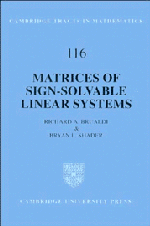
-
Select format
-
- Publisher:
- Cambridge University Press
- Publication date:
- 04 February 2010
- 29 September 1995
- ISBN:
- 9780511574733
- 9780521482967
- 9780521105828
- Dimensions:
- (228 x 152 mm)
- Weight & Pages:
- 0.552kg, 316 Pages
- Dimensions:
- (229 x 152 mm)
- Weight & Pages:
- 0.47kg, 316 Pages
- Series:
- Cambridge Tracts in Mathematics (116)
You may already have access via personal or institutional login- Series:
- Cambridge Tracts in Mathematics (116)
Book description
The sign-solvability of a linear system implies that the signs of the entries of the solution are determined solely on the basis of the signs of the coefficients of the system. That it might be worthwhile and possible to investigate such linear systems was recognised by Samuelson in his classic book Foundations of Economic Analysis. Sign-solvability is part of a larger study which seeks to understand the special circumstances under which an algebraic, analytic or geometric property of a matrix can be determined from the combinatorial arrangement of the positive, negative and zero elements of the matrix. The large and diffuse body of literature connected with sign-solvability is presented as a coherent whole for the first time in this book, displaying it as a beautiful interplay between combinatorics and linear algebra. One of the features of this book is that algorithms that are implicit in many of the proofs have been explicitly described and their complexity has been commented on.
Reviews
"The book is well written and quite readable. It should become an indispensable reference for anyone intersted in questions related to sign solvability of linear systems." Peter M. Gibson, SIAM Review
"...primarily for researchers in combinatorics and linear algebra, it should also be of interest to theoretical computer scientists, economists, physicists, chemists and engineers." Gerard Sierksma, Mathematical Review
Contents
Metrics
Full text views
Full text views help Loading metrics...
Loading metrics...
* Views captured on Cambridge Core between #date#. This data will be updated every 24 hours.
Usage data cannot currently be displayed.
Accessibility standard: Unknown
Why this information is here
This section outlines the accessibility features of this content - including support for screen readers, full keyboard navigation and high-contrast display options. This may not be relevant for you.
Accessibility Information
Accessibility compliance for the PDF of this book is currently unknown and may be updated in the future.


